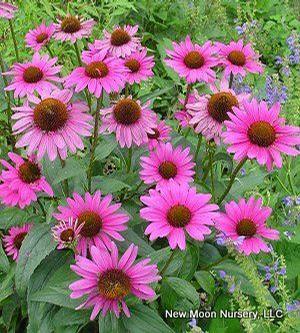New Moon Nurseries

Echinacea purpurea, purple coneflower, is an adaptable and drought tolerant perennial. Benefits wildlife.
Echinacea purpurea
Purple coneflower
Native to North America
FIRST IMPRESSIONS: A couple of decades ago, Echinacea purpurea became one of the first wildflowers to make a successful transition into mainstream horticulture. This sturdy perennial still remains part of the popular crowd. Plants are low maintenance and resilient – thriving in most sunny sites due to their strong stems and deep roots. Striking summer flowers are beloved for their bright pink rays and spiny orange cones. Butterflies flock to the blooms and songbirds relish the seeds that follow.
HABITAT & HARDINESS: Echinacea purpurea occurs in the eastern United States from New York and Pennsylvania west to Wisconsin and Iowa. The range extends south to the Florida panhandle, Louisiana and Oklahoma. Despite its common occurrence in the nursery trade, this species is fairly uncommon in the wild.
Habitats include open woodland edges and clearings, savannas, moist to mesic blackland prairies, meadows, limestone glades and roadsides.
Plants are hardy from USDA Zones 4-9.
PLANT DESCRIPTION: Echinacea purpurea is an upright perennial that branches occasionally. Plants have fibrous roots and form small colonies from short thick rhizomes.
Stems are sturdy and pubescent with leathery oval or lance shaped leaves. The blades are olive green with scattered teeth and a short winged petiole.
Flower heads are borne on long leafless stalks. Each daisy-like head has 10-20 purplish-pink drooping rays. The ray florets surround a robust spiny orange cone made of many disc florets. In bright sunlight, flower heads are sometimes fragrant.
Flowering begins in mid-summer and continues for about a month. Plants occasionally rebloom in autumn. Prickly clusters of dark achenes form from the disc florets and remain into early winter.
Plants grow 2-4’ tall with 2’ spread.
CULTURAL & MAINTENANCE NEEDS: The ideal site for Echinacea purpurea has full sun and fertile well drained soil. Plants tolerate part sun but are less floriferous.
Established plants endure heat and some drought. They also adapt to alkaline, clay or gravelly soils.
Plants are pest resistant and unpalatable to deer and other herbivores. If soil retains excess moisture in winter, plants may succumb to root and crown diseases.
Deadheading can extend the season of bloom but will remove the desirable seed that are savored by goldfinches.
LANDSCAPE USES: This is a good choice for a Wildlife Garden, Cut Flower Garden, Prairie or Meadow. Plants are also used as Butterfly Nectar Plants, Butterfly Host Plants or as part of a Grouping or Mass Planting. Echinacea purpurea has Showy Blooms and is appropriate for Cottage Gardens, Deer Resistant Plantings, Water-wise Landscapes, Low Maintenance Plantings, Perennial Borders and Roadsides.
COMPANION & UNDERSTUDY PLANTS: Try pairing Echinacea purpurea with Coreopsis major, Rudbeckia hirta, Monarda fistulosa, Liatris spicata, Schizachyrium scoparium and Andropogon gerardii.
In garden situations, the cultivars ‘Magnus’, ‘Powwow Wild Berry’ or ‘Ruby Star’ could be substituted. These cultivars could also be mixed sparingly into Echinacea purpurea plantings to add diversity.
TRIVIA: Native bees, butterflies and skippers seek the nectar. Caterpillars of the Silvery Checkerspot Butterfly and several moths feed on the foliage and flowers. The Eastern Goldfinch relishes the nutlike seed.
Echinacea purpurea is widely cultivated but rarely found in the wild due to overharvesting for ornamental and medicinal use.
Roots and above ground parts were used extensively by Native Americans and traditional herbalists for immune system support, detoxification and wound healing.
Height:
3-4 ftSpread:
2-2 ftUSDA Hardiness Zone:
4-9Bloom Color:
Lavender-PinkEchinacea purpurea Characteristics
Attracts Wildlife
- Butterflies
- Songbirds
Attributes
- Naturalizing
- Drought Tolerant
- Dried Flower
- Cut Flower
- Clay Soil
Exposure
- Full Sun to Partial Shade
Deer Resistant
- Deer Resistant
Flowering Months
- September
- August
- July
- June
Foliage Color
- Green
Juglans nigra Tolerance (Black Walnut)
- Yes
Salt Tolerance
- Medium
Soil Moisture Preference
- Moist to Dry
Interesting Notes:
For more information on this plant, visit the USDA PLANTS Database: http://plants.usda.gov/java/profile?symbol=ECPU